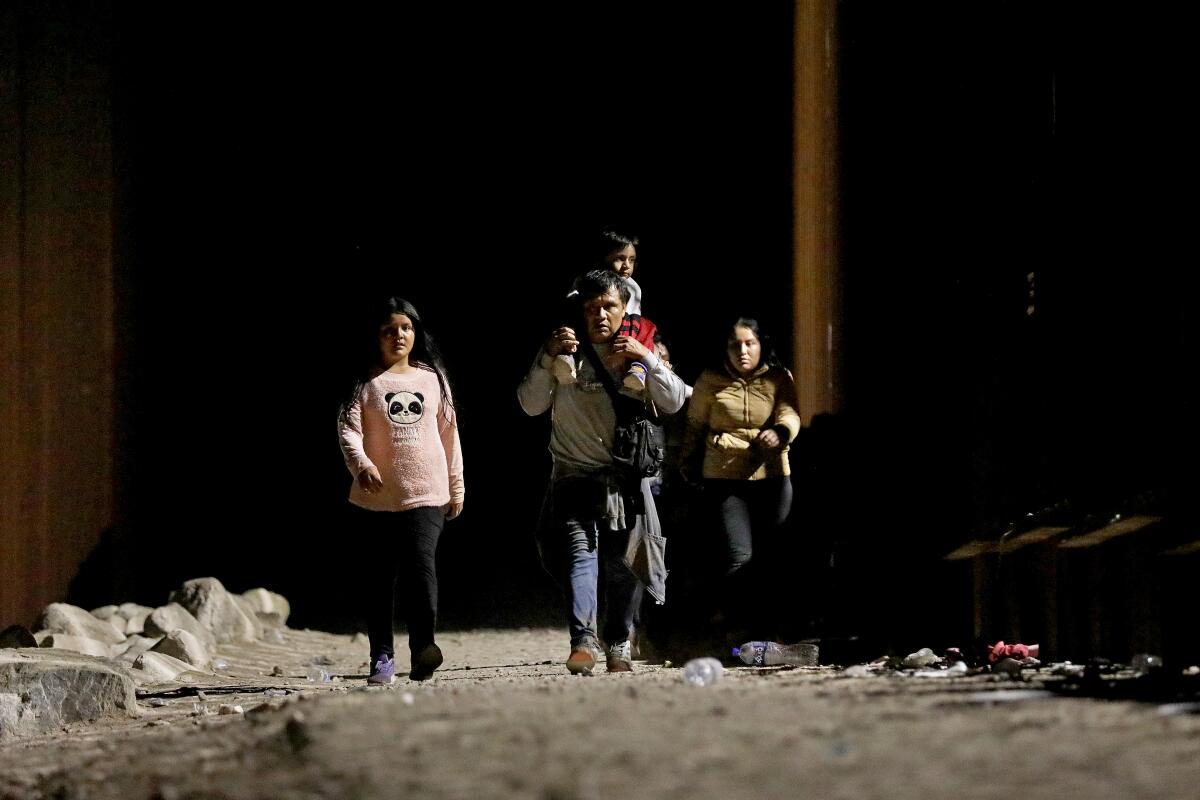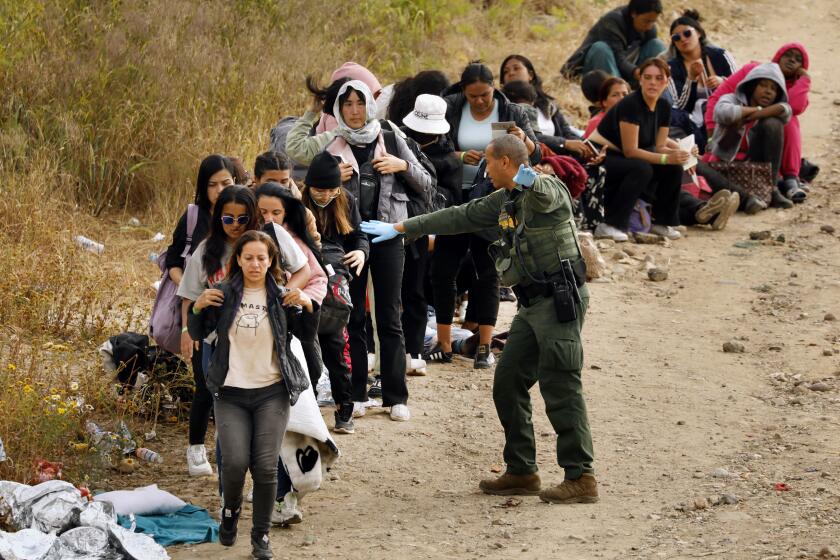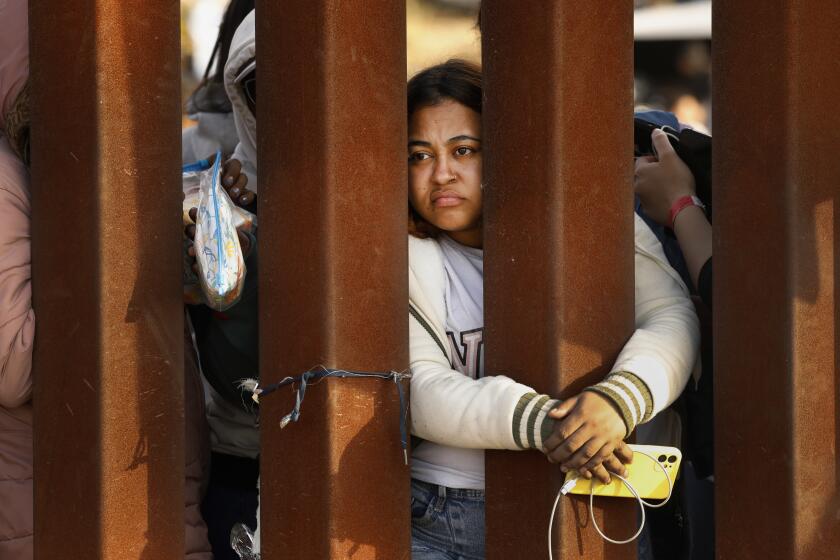Why border crossings have fallen since Trump-era rules expired last week

- Share via
Fewer migrants are crossing the southern border of the U.S., and the doomsday scenarios that many politicians feared would follow the expiration of the pandemic-era restrictions known as Title 42 have not materialized.
The reasons for the decline in border crossings are still unclear — and the trend still in its infancy — but interviews with migrants offer some possible explanations.
Many U.S.-bound asylum seekers, aware of the risks of entering the country after the end of Title 42 — including the threats of deportation, a five-year ban on reentering and even criminal prosecution — are playing a waiting game in Mexican border cities.
Cleven Ismael Peraza, a 26-year-old Venezuelan, is among those who hope to enter the U.S. One of more than 3,000 migrants camped out along the Rio Grande in Matamoros, Mexico, he said he had been turned back after crossing while Title 42 was in place.
“We hear a lot of rumors — that there’s an endless line to get in, that some people are getting in, some people are being deported. We really don’t know exactly what is going on. Right now, seems best to wait,” he said Tuesday.
Title 42, a public health policy invoked to control migration at the start of the COVID-19 pandemic, was lifted Thursday night.
Migrants know “the rules are different now, and [that U.S. officials] can reject our applications for political asylum,” Peraza added.
He said he would continue to try using the problematic CBP One mobile application in hope of scoring an appointment to request asylum at a port of entry. The U.S. government has told migrants to get appointments through the app as opposed to crossing without authorization.
“We are scared. We had a dream to come here and start a new life. Now we are stuck here,” Peraza said.
The Biden administration revealed Wednesday that the downturn in border encounters had continued early this week.
On Monday and Tuesday, border agents encountered fewer than 4,000 people at the southern border each day, according to Blas Nuñez-Neto, a lead Department of Homeland Security official. Since last Friday, the first full day without Title 42, agents have encountered an average of 4,400 migrants per day, he said.
That’s a far cry from the more than 10,000 crossings per day early last week, and from the Homeland Security Department’s projections of 12,000 to 14,000 daily encounters after the end of Title 42.
Nuñez-Neto noted that governments in nearby countries, including Mexico and Guatemala, had deployed law enforcement and military personnel to police their southern borders.
He said U.S. officials “continue to see encouraging signs that the measures we have put in place are working,” but stressed that it was too soon to definitively predict what would happen next.
Migrants waiting in border towns have increasingly turned to TikTok, Facebook, YouTube and other social media sites for updates on how the expiration of immigration policy Title 42 will affect them.
Migration experts and government officials who spoke with The Times agreed that it was too early to make any firm conclusions, but suggested several possible explanations for the decline.
“I think it’s a combination of two things. One, migrants seem to have gotten the message that policies post-Title 42 would be tougher than during Title 42, so rushed in before Thursday night,” said Julia Gelatt, a senior analyst at the Migration Policy Institute. “Second, there is a lot of confusion about what the policies are, and people may be waiting to see how other migrants fare before attempting their crossings.”
The Biden administration has worked hard to broadcast the warning that crossing the border without authorization can lead to serious consequences. A new administration policy restricts asylum access for those who cross into the U.S. without applying for protection on their way to the border.
Homeland Security Secretary Alejandro N. Mayorkas and other Biden administration officials have said repeatedly that the government will punish those who cross the U.S.-Mexico border without permission.
“Do not believe the lies of smugglers,” Mayorkas said last week in a statement directed at migrants. “The border is not open. People who do not use available lawful pathways to enter the U.S. now face tougher consequences, including a minimum five-year ban on re-entry and potential criminal prosecution.”
On Tuesday, the U.S. Customs and Border Protection Twitter account shared photos of migrants being placed on a plane and buses.
“This weekend, Venezuelan migrants were transported by Mexican authorities to interior parts of Mexico from Reynosa. There are long-term consequences to entering the US w/out authorization under Title 8, including removal from the US, including bars to future immigration benefits,” the tweet read.
Nuñez-Neto told reporters Wednesday that Venezuelan, Cuban and Nicaraguan migrants were being turned back to Mexico.
Among the changes since Title 42 expired, border officials have seen roughly 1,000 migrants from Mexico, 510 from Colombia and 470 from Guatemala try to cross each day. That’s compared with roughly 2,400 migrants a day from Venezuela, 1,900 from Mexico and 1,400 from Colombia who had attempted crossings in the days before the end of Title 42.
Caitlyn Yates, a fellow at the Strauss Center for International Security and Law who has been living in Tijuana for the last few months, said that her conversations with migrants in the area revealed that many were waiting in Mexico and trying to better understand the future of U.S. border policy.
Yates said that some migrants are waiting to see whether they will get a slot using the CBP One app. She added that many, especially those from the Western Hemisphere, have heard the messaging about deportations and restrictions on asylum, along with the potential for a five-year ban on reentry.
She said that the deterrence messaging had worked in the short term, but that she didn’t know whether that would last. Migrants’ ability to secure appointments on the app will also affect whether they decide to cross, she added.
The administration has also advertised new legal avenues for migrants to enter the U.S. Those programs
include one in which migrants from Cuba, Nicaragua, Venezuela and Haiti can apply to fly into the
U.S. if they have a financial sponsor and can pass background checks.
The future of the administration’s policies, however, remains in limbo. The program allowing migrants to apply for legal entry is being challenged in a federal court in Texas. And the American Civil Liberties Union recently sued the Biden administration over its asylum restrictions, saying they were unlawful and resembled Trump-era policies.
Inside the government, officials have expressed some relief about the recent numbers, said one Homeland Security official, speaking to The Times on condition of anonymity because they were not authorized to speak publicly.
“There is certainly the view that our messaging is working,” the official said.
“The deterrence message is working, so we need to keep up the pressure to demonstrate that there are people being removed through this process,” the official said of the thinking in the department. “People are worried that if there aren’t demonstrated consequences, the numbers will go back up.”
The official was also cautious about whether the numbers would hold, and said it was too early to tell what the long-term effects of the policies would be.
U.S. government warnings have caused some asylum seekers to take a guarded approach.
By the morning after Title 42 expired, Alexandre Jean Verneau had slept for the four previous nights along the border across from El Paso, planning to give himself up to U.S. border officials.
But he had decided not to turn himself in with hundreds of other migrants who had also been waiting for days on the strip of no-man’s land on U.S. territory along the Rio Grande. The 26-year-old Haitian feared they were being allowed to enter as a “trick” and that he could end up being deported back to Haiti, he said.
Since then, Verneau has found work in construction in Ciudad Juárez, on the Mexican side of the border. He says he plans to wait there until he can secure an appointment via the CBP One app. Like so many others, he fears that entering illegally now could lead to deportation and other legal troubles.
“I’ve been trying and trying, day and night, but haven’t been able to upload the application,” he said Tuesday. “I don’t have a date for an appointment yet. I don’t know when I’ll have one.... But I want to get out of here now. I want to go to the United States.”
Verneau is renting a room in a house in Ciudad Juárez.
For now, he plans to remain in Juárez until he can get an appointment.
Aleaziz reported from Healdsburg, Calif., and McDonnell from Mexico City. Special correspondents Gabriela Minjares in Ciudad Juárez and Juan José Ramírez in Matamoros contributed to this report.
More to Read
Get the L.A. Times Politics newsletter
Deeply reported insights into legislation, politics and policy from Sacramento, Washington and beyond. In your inbox three times per week.
You may occasionally receive promotional content from the Los Angeles Times.











